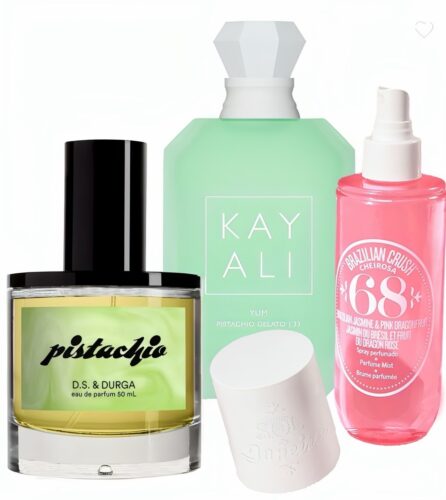Fragrance and weight loss, two seemingly unrelated territories are blending in a surprising way. Beauty and fragrance marketing leader Pierre Vouard recently coined the phrase “spraying cravings instead of eating them,” observing that as GLP-1 medications like Ozempic curb appetite, users are looking for sensory indulgence through scent, particularly gourmand fragrances.
Founded in 1996, Laura Mercier expanded into fragrance around 2001, introducing gourmand-leaning scents such as Almond Coconut and Ambre Vanille. Rich, comforting, and dessert-inspired perfumes. These early gourmand lines helped pave the way for the edible-fragrance trend we see growing today.
The Ozempic Effect: Rewiring Cravings
GLP-1 agonist such as Ozempic are used for their appetite suppression and weight-loss capabilities. But emerging evidence suggests they also influence broader reward systems in the brain, dampening cravings for food, alcohol, and surprisingly, sometimes even shopping or compulsion-driven behaviours. .
Some users report that as their hunger dissipates, fragrance becomes a substitute for sensory cravings. In one case, a perfume fan said simply: “Perfume replaced my cravings for sweets”. Others describe a heightened attraction to sweet, food-like perfumes. Think vanilla frosting, caramel glaze, marshmallow and pistache, to name a few. An effect dubbed the “Ozempic Smell” phenomenon.
Perfume preference isn’t only psychological, it’s also physiological. GLP-1 medications affect the brain’s reward pathways and may alter dopamine signalling, redirecting pleasure from tasting to smelling stimuli. On the skin level, rapid weight loss often leads to dryness and changes in sebum production. Dry skin doesn’t hold fragrance as well, so richer, longer-lasting gourmand scents are perceived as more comforting and effective.
Elevated cortisol which is common in weight-loss treatment, can shift skin’s pH, oil output, and temperature, all of which influences how scents wear on the skin, and are perceived. A perfumer noted that when people “can’t eat the cake, they want to smell like it,” illustrating the emotional and sensory substitution occurring.
 Market Momentum: Dessert in a Bottle
Market Momentum: Dessert in a Bottle
These shifts have shaped fragrance trends. Searches for gourmand perfumes soared as data shows a 58% year-over-year jump in related terms, with “pistachio perfume” spiking 139% Brands like Kayali (Yum Pistachio Gelato) and Sol de Janeiro (Cheirosa 62) have capitalised on this sweet nostalgia trend. Perfumes that smell like dessert such as my favorite D.S. Durga Pistachio have become comforting staples in many scent wardrobes and will continue to evolve. (50 ml | € 167)
In summary, the “Ozempic effect” is about more than appetite suppression. It signals a shift in how we move from taste to scent. Gourmand fragrances, with their rich, dessert-like notes, offer a nostalgic escape and a sweet indulgence without the calories. For many, they’ve become a comforting, luxurious way to satisfy a sweet tooth evoking warmth, joy, and emotional reward every time you spray.
